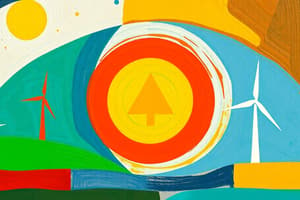Podcast
Questions and Answers
What causes sea levels to rise?
What causes sea levels to rise?
- Decrease in water temperature
- Melting glaciers and ice sheets on land (correct)
- Melting floating ice and icebergs
- Increase in atmospheric pressure
What percentage of incoming solar energy is absorbed by Earth's oceans?
What percentage of incoming solar energy is absorbed by Earth's oceans?
- 64%
- 4%
- 11%
- 20% (correct)
Melting floating ice and icebergs contribute to rising sea levels.
Melting floating ice and icebergs contribute to rising sea levels.
False (B)
Earth's atmosphere absorbs more solar energy than the hydrosphere.
Earth's atmosphere absorbs more solar energy than the hydrosphere.
Name one human activity that increases the amount of greenhouse gases in the atmosphere.
Name one human activity that increases the amount of greenhouse gases in the atmosphere.
What is the name of the program aimed at reducing vehicle emissions?
What is the name of the program aimed at reducing vehicle emissions?
The total percentage of incoming solar energy absorbed by Earth is ____%.
The total percentage of incoming solar energy absorbed by Earth is ____%.
The anthropogenic greenhouse effect refers to the warming of the Earth due to __________ activities.
The anthropogenic greenhouse effect refers to the warming of the Earth due to __________ activities.
Match the sources of greenhouse gases with the activities that contribute to them:
Match the sources of greenhouse gases with the activities that contribute to them:
Match the following components of Earth's climate system with their descriptions:
Match the following components of Earth's climate system with their descriptions:
Which of the following is NOT a source of clean energy?
Which of the following is NOT a source of clean energy?
Which of the following is NOT a source of personal greenhouse gas emissions?
Which of the following is NOT a source of personal greenhouse gas emissions?
Rising sea levels are one of the effects of climate change in the Arctic.
Rising sea levels are one of the effects of climate change in the Arctic.
Using renewable energy sources can help reduce personal greenhouse gas emissions.
Using renewable energy sources can help reduce personal greenhouse gas emissions.
What was the issuance year of Ontario's Climate Action Plan?
What was the issuance year of Ontario's Climate Action Plan?
To reduce environmental impact in agriculture, one might adopt sustainable ______ practices.
To reduce environmental impact in agriculture, one might adopt sustainable ______ practices.
Name one step individuals can take to reduce their personal greenhouse gas emissions.
Name one step individuals can take to reduce their personal greenhouse gas emissions.
Match the following impacts on climate change with their descriptions:
Match the following impacts on climate change with their descriptions:
One effective way to lower emissions from heating and cooling is to reduce _____ use.
One effective way to lower emissions from heating and cooling is to reduce _____ use.
Match the steps to reduce emissions with their descriptions:
Match the steps to reduce emissions with their descriptions:
Flashcards
Clean Energy Sources
Clean Energy Sources
Energy sources that produce minimal or no greenhouse gas emissions, contributing to a cleaner environment.
Climate Change Impacts in the Arctic
Climate Change Impacts in the Arctic
The impact of climate change on the Arctic region, characterized by rising sea levels, shifting ocean currents, the release of greenhouse gases, altered weather patterns, habitat loss, and increasing health risks for Arctic communities.
Risks of Geoengineering
Risks of Geoengineering
Three potential risks associated with geoengineering, a deliberate intervention in Earth's climate system. These risks include unintended environmental damage, uneven benefits leading to some areas being worse off than others, and ethical concerns regarding the large-scale manipulation of the climate.
Ontario Climate Action Plan
Ontario Climate Action Plan
Signup and view all the flashcards
Reducing Construction Industry's Environmental Impact
Reducing Construction Industry's Environmental Impact
Signup and view all the flashcards
Earth's Energy Absorption
Earth's Energy Absorption
Signup and view all the flashcards
Earth's Orbital Changes
Earth's Orbital Changes
Signup and view all the flashcards
Earth's Climate System
Earth's Climate System
Signup and view all the flashcards
Drive Clean Program
Drive Clean Program
Signup and view all the flashcards
Solar Energy Absorption
Solar Energy Absorption
Signup and view all the flashcards
Anthropogenic Sea Level Rise
Anthropogenic Sea Level Rise
Signup and view all the flashcards
Anthropogenic Greenhouse Effect
Anthropogenic Greenhouse Effect
Signup and view all the flashcards
Greenhouse Gases
Greenhouse Gases
Signup and view all the flashcards
Deforestation
Deforestation
Signup and view all the flashcards
Melting Ice and Sea Level Rise
Melting Ice and Sea Level Rise
Signup and view all the flashcards
Transportation Emissions
Transportation Emissions
Signup and view all the flashcards
Heating & Cooling Emissions
Heating & Cooling Emissions
Signup and view all the flashcards
Use Public Transport
Use Public Transport
Signup and view all the flashcards
Reduce Energy Use
Reduce Energy Use
Signup and view all the flashcards
Use Renewable Energy
Use Renewable Energy
Signup and view all the flashcards
Study Notes
Clean Energy Sources
- Biomass, tidal, solar energy, wind energy, hydropower, geothermal
- Rising sea levels
- Changes in ocean levels
- Release in greenhouse gases
- Distribution in weather patterns
- Loss of habitats
- Changes in wildlife
- Harmful effects
Risks of Geoengineering
- Unexpected damage to environment
- Noise
- Harmful effects to ecosystem
- Ethical concerns
Ontario's Climate Change Plan
- The Ontario Climate Action Plan was issued in August 2007
- Reduce consumption of waste, increase energy efficiency, use sustainable materials
Steps to reduce industries impact on Climate Change
- Adopt sustainable materials
- Increase energy efficiency
- Reduce consumption waste
Steps for the agriculture Industry
- Adopt sustainable farming practices
- Improve soil management
- Reduce livestock emissions
Studying That Suits You
Use AI to generate personalized quizzes and flashcards to suit your learning preferences.




